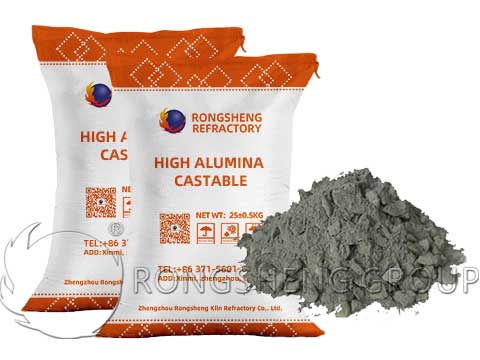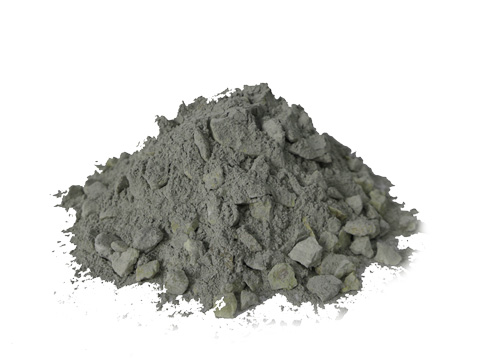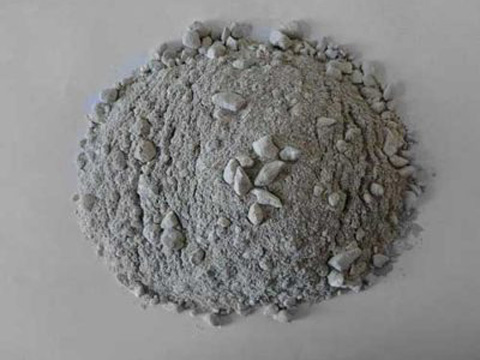High alumina castable is one of the best-selling refractory castables of Rongsheng refractory manufacturers. There are many customers who continue to buy high-alumina castables from our factory, including customers in South Africa. High alumina castables are suitable for various heat treatment furnace linings and burners, blast furnace hot blast stoves, heating furnaces, electric furnace tapping grooves, high-temperature sections of shaft kilns, rotary kiln heads, power plant boilers, and other industrial furnace linings. So, what is the high alumina castable refractory in South Africa?

High alumina castable is a type of low cement castable with a cement content of less than 8%. It is a refractory castable made of high alumina bauxite clinker as aggregate, refractory clay as powder, adding aluminate cement and sodium tripolyphosphate according to the formula proportion. Its use temperature is above 1400 ℃, and the aluminum content reaches 74%. It is a commonly used castable for kiln lining.
High alumina castables have the characteristics of high refractoriness, strong thermal stability, and good thermal shock resistance. high alumina castable refractory in South Africa. Different from ordinary refractory castables, most of the calcium aluminate cement in the matrix is replaced by ultrafine powder, and at the same time, appropriate additives are added to achieve and exceed the performance of ordinary cement castables.
High alumina refractory castables are now widely used in the construction and daily maintenance of various industrial kilns. High-alumina castables generally have high strength at room temperature, and can also be made into prefabricated parts and installed on the kiln rotary site. High-alumina castables can work in parts that are eroded by molten iron, molten steel, and slag and have a higher working temperature. The variety of high-alumina castables has increased rapidly, and the quality of high-alumina castables has gradually improved. Rongsheng‘s new generation of high-alumina castables includes low-cement refractory castables, ultra-low cement castables, and cement-free castables.
There is a difference between high alumina castables and high alumina low cement castables.
The high alumina castable refractory cement is added at 12%, which is convenient for construction and fast setting in the early stage but has a high calcium content, and then later use strength is not as good as that of low cement castables. The high alumina low cement castable refractory cement is added at 6%, with low calcium content and good later uses strength.
If used for chimney lining, it is better to use high alumina castable. Due to a large amount of refractory cement added, the chimney lining will be impacted by flue gas and water mist. Due to a large amount of cement, the fast setting speed of construction, and the smooth surface of the high-alumina castable surface, the high-alumina castable is more suitable in this case.
For high alumina low cement castables, the amount of refractory cement binder added is small, the amount of water added during construction is small, it is easy to bake, and it has good strength and high-temperature resistance. Moreover, the raw materials and binders of high-aluminum low-cement castables are better than the matrix of general high-aluminum castables, and the refractory cement are also relatively different in terms of labels. The price is also relatively higher than that of high-aluminum castables.
High alumina low cement castables are relatively used in high-temperature areas. Better than high aluminum castables. The material matrix used is also different than high alumina castables. So these two castables are different.
high alumina castable refractory in South Africa. The construction of high alumina castables is very important. Especially the amount of water added. Be sure to control the amount added according to the construction instructions, and do not add more. When stirring, the aggregate should be used first, then the fine powder should be added, the binder should be added, and the stirring time should not be less than 5 minutes.
After the initial setting and final setting of the high-alumina refractory castable after construction, the high-alumina castable must be cured before it can be demoulded, and then it can be put into use for baking after an appropriate period of natural curing.
The price of high-aluminum castables is determined according to the bulk density and aluminum content. The price of castables produced from high-aluminum materials with low bulk density will be relatively low. If it is castable with high bulk density and high aluminum content, the price will be relatively high.
Buy High Aluminium Castables Quickly
Rongsheng refractory material manufacturer has an advanced and environmentally friendly unshaped refractory castable production workshop. The main castable products of our factory are steel fiber castable, wear-resistant castable, high-alumina castable, non-stick alumina castable, explosion-proof quick-drying castable, alkali-resistant castable, and so on. high alumina castable refractory in South Africa. Quickly buy high alumina castables, just send us an email. We will get in touch with you as soon as possible and provide you with a free quotation and sample service.



